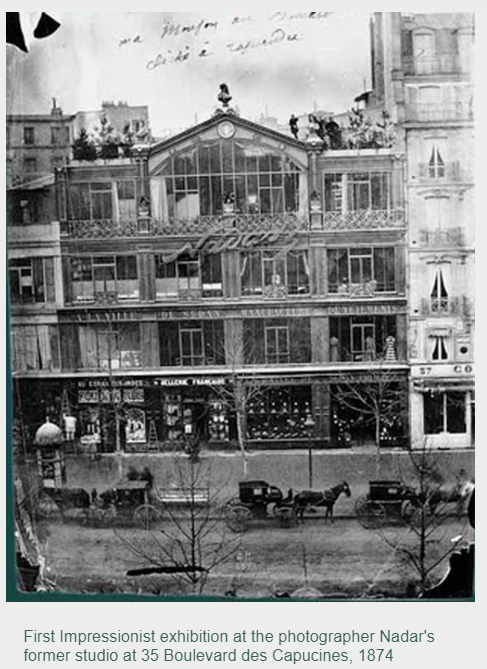
Eight Impressionist Exhibitions were held in Paris between 1874 and 1886.
Due to their frustration with the Paris Salon, the group which was later to become known as the Impressionists organised the Société Anonyme Coopérative des Artistes Peintres, Sculpteurs, Graveurs (Co-operative and Anonymous Association of Painters, Sculptors, and Engravers) in 1873, with the intention of exhibiting their artworks independently.

The work of these artists had been frequently rejected by the Salon jury in Paris. When Édouard Manet submitted Le Déjeuner sur l’Herbe to the jury in 1863 and it was rejected, a number of disgruntled artists appealed to the Emperor of France, Napoleon III, who gave permission for rejected paintings and sculptures to be exhibited at the Salon des Refuses which was installed adjacent to the regular exhibition.

The idea of an independent exhibition was radical. No group of artists had previously organised a major self-promoting show outside of the official French Academy’s annual Salon or the short lived Salon des Refusés.
However, this group, which included Claude Monet, Pierre-Auguste Renoir, Camille Pissarro, and Alfred Sisley, had all experienced rejection by the Salon jury in recent years and were also frustrated with having to wait a whole year in between exhibitions.
They needed to show their work and they wanted to sell it. So, in an attempt to gain recognition outside the official channel of the Salon, these artists pooled their money and rented a studio that belonged to the famous photographer Nadar (Gaspard-Félix Tournachon).

The organisers invited a number of other progressive artists to join them in their inaugural exhibition, including the older Eugène Boudin, who had influenced Monet in adopting plein air (outdoor) painting some years before.
Members of the Association, which soon included Cézanne, Berthe Morisot, and Edgar Degas, were expected to forego participation in the Paris Salon in favour of their independent exhibition.
However, Édouard Manet refused, even though the group regarded him as as inspiration and a leader. Although he had set up his own pavilion during the 1867 World’s Fair, he was not interested in giving up on the judgement of the Salon jury, as the status of being accepted by the Salon was important to him, even if he had to endure the ridicule of the jury in the process.
In total, thirty artists participated in their first exhibition, held in April 1874 at Nada’s studio. Not surprisingly, the first exhibition wasn’t a financial success. Many of the critics derided the works exhibited as they were considered to be too ‘sketchy’ and unfinished. The subject matter, of landscapes and portraits of ordinary people, which was such an important part of the Impressionist style, was thought to be too commonplace, and not meeting Salon standards.

Dubbed the Impressionists by the critics that year (based largely on Monet’s Impression, Sunrise, which he completed in 1872) the group didn’t adopt the name until 1877.
During the period from 1874 through to 1886 the Association had a fluid membership, with the number of participating artists ranging from nine to thirty. At times there were philosophical and political differences leading to heated disputes and fractures. Camille Pissarro, the eldest, was the only artist who exhibited in all eight shows, while Morisot participated in seven.
By 1886 most of the core members were developing new, individual styles and the Association no longer attempted to mount any new joint exhibitions.
However, the Impressionist exhibitions mark a turning point for art promotion in the modern era, recognising that a single, annual exhibition was insufficient to support artists’ endeavours to sell their works.
This blog is just a short excerpt from my art history e-course, Introduction to Modern European Art which is designed for adult learners and students of art history.
This interactive program covers the period from Romanticism right through to Abstract Art, with sections on the Bauhaus and School of Paris, key Paris exhibitions, both favourite and less well known artists and their work, and information about colour theory and key art terms. Lots of interesting stories, videos and opportunities to undertake exercises throughout the program.